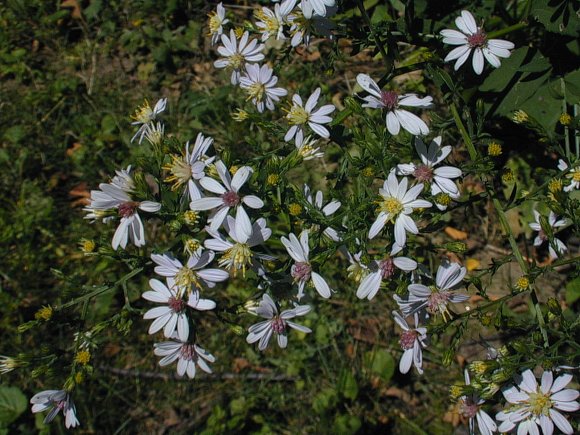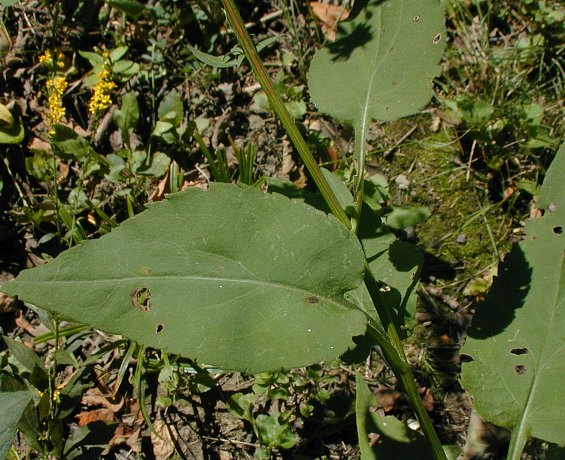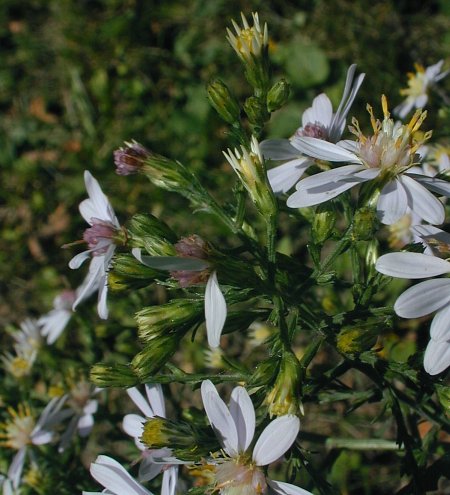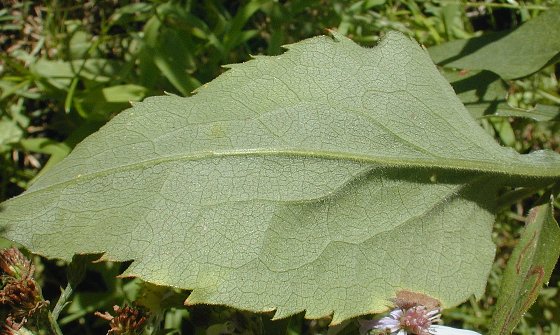Description: This perennial wildflower is 2-3½' tall, sending up one or more leafy stems during the late spring. Initially, these stems are erect to ascending, but later in the year they sometimes sprawl across the ground. These stems are unbranched below and occasionally branched above; they are light green to reddish brown, terete, glabrous below, and lined with short hairs above. The alternate leaves are up to 4" long and 2½" across, becoming smaller as they ascend the stems. The lower leaves are cordate to cordate-ovate in shape and coarsely serrated to crenate-serrate along their margins. The upper leaves are cordate-ovate to ovate in shape and crenate-serrate to slightly crenate-serrate along their margins. The petioles are up to one-half the length of the blades, becoming relatively shorter as they ascend the stems; these petioles are conspicuously winged along their margins and they are often ciliate or slightly pubescent. The upper surfaces of the leaves are glabrous to sparsely covered with short hairs, while their lower surfaces are usually glabrous, except for some fine hairs along the major veins. However, some young leaves may have sparse short-pubescence on their lower surfaces. The central stem and upper lateral stems (if any) terminate in panicles of flowerheads that are ¾-1¾' long and about one-half as much across. The lateral branches of these panicles are ascending; the peduncles of the flowerheads are short (up to ½" in length). The central stalk, lateral branches, and peduncles are light green to reddish brown, terete, and either glabrous, short-pubescent, or lined with short hairs.

Each flowerhead is about ½" across, consisting of about 8-15 ray florets that surround 8-12 disk florets. The petaloid rays of the flowerheads are lavender, light blue-violet, or white. The corollas of the disk florets are initially cream-colored or yellow, but they later become reddish purple. Around the base of each flowerhead, there are phyllaries (scale-like floral bracts) in several overlapping series; individual phyllaries are 2-5 mm. in length. Individual phyllaries are linear-lanceolate to narrowly lanceolate, appressed together or slightly spreading, and they have dark green patches near their tips that are diamond-shaped. Leafy bracts up to 1" long occur along the central stalks and lateral branches of panicles; they are linear-oblong or elliptic in shape and entire (smooth) along their margins. The blooming period occurs from late summer into the autumn and lasts about 1-3 months. Afterwards, the florets are replaced by achenes with small tufts of hair; they are distributed by the wind. The achenes are 2.0-2.5 mm. long, oblongoid-oblanceoloid in shape, and brown to purplish brown. The root system is fibrous and short-rhizomatous; an older plant may develop a small woody caudex. This wildflower spreads by reseeding itself and by forming clonal offsets from the rhizomes. A rosette of semi-evergreen basal leaves is created during the autumn that can persist until the spring. These basal leaves are ¾-3" long, cordate-ovate in shape, and crenate-serrated along their margins. Their upper surfaces are medium green and glabrous, while their lower surfaces are pale green and glabrous to finely hairy along the major veins. The petioles are about the same length as the corresponding basal leaves; they are narrow or slightly winged.

Cultivation:
The preference is partial sun, mesic to dry conditions, and soil that
contains loam, clay-loam, or rocky-loam. The leaves may become
yellowish green when they are exposed to bright sunlight; the lower
leaves may become wilted and fall off their stems during hot dry
weather. Sometimes powdery mildew attacks the leaves during the late
summer or fall when moisture is abundant.
Range & Habitat:
The native Arrow-Leaved Aster is common in most areas of Illinois,
except some counties in the south-central area of the state (see
Distribution
Map).
Habitats include upland woodlands, rocky
woodlands, wooded slopes, thinly wooded bluffs, woodland edges,
savannas, rocky glades, grassy thickets, small meadows in wooded
areas, and edges of yards. This aster tolerates disturbance to some
extent.

Faunal
Associations:
The nectar and pollen of the flowerheads attract many kinds of insects,
including long-tongued bees, short-tongued bees, Syrphid flies, bee
flies, wasps, and occasional butterflies or skippers. Caterpillars of
the butterflies Chlosyne nycteis
(Silvery Checkerspot) and Phyciodes
tharos (Pearl Crescent) feed on the
foliage of asters (Symphyotrichum
spp.), while the caterpillars of many moths
feed on the foliage, flowerheads, developing seeds, stems, or roots
(see Moth Table). Other
insect feeders include leaf beetles, lace bugs,
plant bugs, stink bugs, aphids, leafhoppers, and the larvae of
leaf-mining flies and fruit flies (see Insect Table for a
list of these species). Among vertebrate animals, the Wild
Turkey and Ruffed Grouse occasionally eat the seeds and young foliage
of asters, while such mammalian herbivores as deer, rabbits,
groundhogs, and livestock browse on the foliage.
Photographic Location:
Border of a wooded area at Crystal Lake Park in Urbana, Illinois.

Comments: Arrow-Leaved Aster (Symphyotrichum sagittifolium) is one of several woodland asters with relatively small flowerheads that have cordate or cordate-ovate lower leaves. While the leaves can become rather coarse, the panicles of abundant flowerheads are often showy. This species has an appearance that is similar to Drummond's Aster (Symphyotrichum drummondii), Heart-Leaved Aster (Symphyotrichum cordifolium), and White Arrowleaf Aster (Symphyotrichum urophyllum), which occur in similar habitats. Drummond's Aster has stems and leaf undersides that are evenly pubescent, while the stems of Arrow-Leaved Aster are either glabrous or they are lined with hairs, and the undersides of its leaves are either glabrous or they have fine hairs along the major veins. Heart-Leaved Aster can be distinguished by the narrow petioles of its alternate leaves, while those of Arrow-Leaved Aster are conspicuously winged. Sometimes the latter is considered a variety of Heart-Leaved Aster, or Symphyotrichum cordifolium sagittifolium (Jones, 1989). Finally, Arrow-Leaved Aster and White Arrowleaf Aster are regarded as the same species by some authorities (e.g., efloras, USDA, and ITIS), while Mohlenbrock (2014) considers them to be distinct. An argument for the latter point-of-view can be made as, compared to Arrow-Leaved Aster, White Arrowleaf Aster has more narrow upper leaves (typically ovate to lanceolate), the margins of its leaves are less strongly toothed or they lack teeth, and its phyllaries have green central stripes, rather than diamond-shaped patches of dark green toward their tips. In addition, the petaloid rays of this latter aster are almost always white. All species in this complex of asters were assigned orginally to the Aster genus.